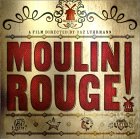FILM REVIEW
-----------------

PHOTO: GLENN
CAMPBELL
BAZ
LURHMAN'S
MOULIN ROUGE !
An
Electrical Parade with Garters
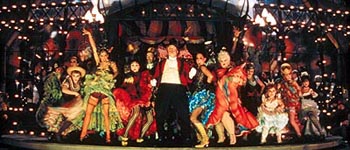
by Dr. Susan Block
POSTED 5.16.01 11
PM (PST)
Baz Luhrman's Moulin Rouge! has about as much to do with Fin
de Siècle Paris as McDonald's French Fries have to do with
French cooking. But that's not the big problem, even for a Boho like
me. After all, throwing rock anthems into the Middle Ages or high heels
into ancient Rome is all the rage in modern cinema. I call it Remixed
History. So though it's a bit odd to see the star of the Moulin Rouge,
Nicole Kidman's Satine, looking more like Joan Crawford than Jane Avril,
and it's rather bizarre to hear 1980s pop being sung in a cyber-Gay
Nineties setting (eg, picture Madonna's "Like a Virgin" being
grunted by a fat old pimp/impressario to a horny old duke), such anachronisms
are forgivable-and even fun--when they're knowing and satirical, as
these certainly are.
The problem with Moulin Rouge! is also its strength, and that's its shameless, manic, spectacular spectacle. After a nice touch of Victorian-style graphics for the opening credits and just a bit of the old black-and-white, Baz fills his screen with the most vibrant colors, exotic costumes, fantastic sets, swooping camera angles and lightening-quick cuts I've ever seen in feature films. For the first 40 minutes or so, I loved it. I imagine Lurhman was trying to recreate the feeling of being high on Absinthe (the demon drink of the Gay Nineties) with the Ecstasy Rave Crowd in mind. With a variety of flashing, sparkling, shimmering and twinkling lights, he brilliantly recreates the excitement of what it might have felt like to see electricity, a relatively new invention, light up the night for the first time in the history of humanity.
It worked for me, at least at first. I wanted to be there. I wanted to dance at this MTV-style Moulin Rouge lit up like an Electrical Parade with garters. I wanted to inhabit the gnarled ateliers of this Hobbitesque Montmartre. I wanted to rehearse in Toulouse-Lautrec's whimsical Warholesque loft. I wanted to make love in Satine's glittering jewelbox boudoir. I didn't care that Baz blended the bohemian fashions and trends of 12 different times and places from the 19th, 20th and 21st centuries. Remix away, Baz baby! Leave real history to the libraries! I was infatuated, intoxicated, reeling, laughing, high as an Absinthian kite, hanging on tight for this shocking, jarring, dizzying, dazzling, trippy, kooky, witty, breathless, awesome, special-effects-laden roller coaster ride.
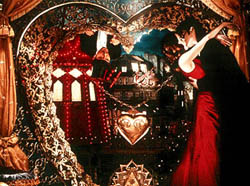
Satine (Nicole Kidman)
and Christian (Ewan McGregor) kiss in Satine's glittering
jewel box boudoir as Toulouse (John Leguizamo) watches from the window
The problem is that Baz never lets you off the roller coaster. You have to ride it for two hours. After about an hour of dizzying/dazzling effects without much of a storyline to cling to, I didn't want to be there anymore. I wanted to go to the bathroom. I wanted an Exedrin. On second thought, maybe that is how you feel when you drink Absinthe.
It's kind of a shame, because Moulin Rouge! is truly a tour de force of spectacle that aggressively creates its own amazing world. It manages to generate a great deal of excitement with hardly any violence, a rarity in any modern movie. Catherine Martin's costumes are splendid. I wish I could have them all in my wardrobe. No, they're not authentic Fin de Siècle. Nicole Kidman as Satine does dress like Joan Crawford (but a fabulous Joan Crawford. I lusted after her drapey black lace Seduce-the-Duke gown). The other dancers have a hint of the old style of Jane Avril, La Goulue and other real stars of the Moulin Rouge, but are hiphopped up for modern sensibilities.
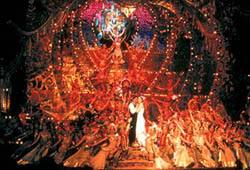
Spectacular Spectacular
!
The sweetest surprise of Moulin Rouge! is the music. It is cleverly woven into the plot (I'll get to that plot in a minute). Nicole Kidman has a nice serviceable warble, and Ewan McGregor has a second career here. He's a wonderful, charmingly expressive singer. The use of old show tunes from The Sound of Music and old rock tunes like Elton John's "Your Song" is silly and annoying if you're expecting any kind of authenticity. But if you accept Baz's Remixed History premise, it works. At least, it mostly works. At least, it made me laugh and didn't make me cringe--too often. My hat is off to Luhrman and crew for daring to pull off a 21st century movie musical. In these days of reality-everything, it's pretty revolutionary.
So, what about that plot? Pure shmaltz. Baz and co-writer Craig Pierce could have used a little help from Shakespeare on this one (Baz' energetic style mixed with Will's genius script is what made Romeo + Juliet such a pleasure). Here it is: Penniless but talented writer named Christian meets beautiful courtesan/can-can star named Satine (could we lay the symbolism on any thicker with these names, Baz?). They fall in love. But Satine is bound to an evil old investor, the wealthy powerful duke (Richard Roxburgh) who vows to have her beloved Christian killed unless she gives him up. In the end, love conquers all, except death. Satine, consumed (by Tuberculosis? Syphilis? The making of this film?), collapses into her lover's arms and dies. Christian's tears fall, glittering in splinters of light, this being the tragic side of Baz's Electrical Parade.

Poor Consumptive
Satine, Star of Baz's Electrical Parade
Don't worry. I haven't "ruined it" by telling you the ending, since the beans are pretty much spilled in the first two minutes of the film. It begins with a red velvet curtain opening on an impossibly picturesque Fin de Siècle Parisian Right Bank, created almost entirely on a computer, as we hear David Bowie crooning the old Nat King Cole song "Nature Boy." The mix of cultures filtered through cyberspace let's you know that this is not your great granddad's Moulin Rouge.
Then we see the Nature Boy himself, the talented Ewan McGreggor as Christian. There he is in his tiny room at the Hotel Blanche, typing with fervor into the starry night, booze at his side, tears in his eyes, writing, like a good Bohemian, about the importance of LOVE and its tragic loss. In voiceover, Christian tells you his great love Satine is dead (so much for suspense). A flashback the length of the entire film begins, with fortune literally falling though Christian's ceiling in the form of Henri de Toulouse-Lautrec (a lisping, leering, somewhat miscast John Leguizamo) and his band of merry BoHos. They're rehearsing their new show "Spectacular Spectacular" for the Moulin Rouge, but they need a writer. And wouldn't you know it, our Christian is just a fount of lyrics from some of the twentieth century's greatest hits, all of which is très avant garde for these denizens of the nineteenth century. So they give him a hit of the demon Absinthe, everybody heads for the Moulin Rouge, Baz's visuals go bananas, Christian/Ewan falls for Satine/Nicole like Romeo/Leo fell for Juliet/Claire, and we're off to the races.
Too much racing and not enough pacing aside, it's a magnificent effort, rather like the great garish Indian elephant that stands before the Moulin Rouge (and rumor has it that Baz was inspired by the gaudy "Bollywood" musical love films of India). But the plot is so papery thin (with no subplots to buoy it) that I did find myself longing for certain missing elements of authentic Moulin Rouge life.

A few fleeting blurry
can-can flurries is all Baz gives us!
For instance, I would have liked to see a little more real can-can, especially from the star. Minimal can-can, and the fact that Satine is sick and doomed to die from the beginning weighs down her sex appeal. She's beautiful and high-spirited, but she's such a helpless woman. No powerful Madonna, not even a healthy Marilyn is our consumptive Satine who looks coolly exquisite but faints, coughing up blood, after almost every performance. She sings her heart out. She flies around on a trapeze. But she doesn't can-can. Those incredibly gorgeous sexy legs mostly just waltz and loll around. I saw her do just one high kick in the whole film. If Nicole couldn't do it, they should have used a body double. Call it nitpicking, if you like, but the star of the Moulin Rouge should can-can!

Troupe de Mlle de Églantine
(including Jane Avril and Cleopatre Gazelle)
Henri de Toulouse-Lautrec .... 1896
While I'm picking nits, I would have liked to see some of the real Toulouse-Lautrec's posters of the real Moulin Rouge. Just a shot or two. T-L's brilliant compositions of color, passion, parody and pathos, foreshadowed modern graphic design, portraying the intoxicating mix of radical politics and popular entertainment that characterized Montmartre and revolutionized Paris. Couldn't Baz get the rights to use them? Didn't he think they were exciting enough? He doesn't even show Toulouse with a paintbrush in his hand. I understand putting Elton John in the Gay Nineties. Now, I understand Baz not wanting his cinematic artistry to be limited by the hard cold facts of history. But in all his thousands of cuts in this film, why couldn't one of them show this beloved, world-renown painter painting?
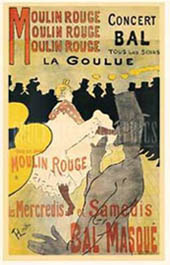
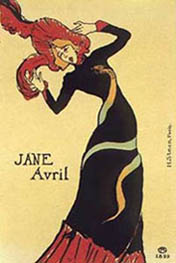
Toulouse-Lautrec
Posters Celebrating La Goulue (1891) and
Jane Avril (1899), Stars of the Real Moulin Rouge
.........
Finally, I would have liked to have seen a little nudity. Not a lot! I wasn't looking for Moulin Porn! But occasional glimpses of public nudity were such a big part of the excitement of the Moulin Rouge and other dance halls of Gay Paris, as well as such a vital aspect of the art of many of Toulouse-Lautrec's contemporaries, like Renoir and Matisse, that the fact that it was completely missing in Luhrman's film feels falsely prudish.

Reclining Nude ..........................
Auguste Renoir
I imagine that
Baz & Co. chose to make Moulin Rouge! nudity-free so that
it could get a PG-13 rating. Got to entice those pre-teen girls who
see their favorite movies 10 times each, I suppose. Not that there isn't
quite a bit of sex in this movie. Christian and Satine do kiss and paw
each other a lot. There's also a great deal of dry-humping, some of
which is erotic, most of it humorous. Plus lots of naughty, delicious
images of garters and ruffles, corsets and panties (some of which I
loved so much that I can't wait until Moulin Rouge! comes out
on video so I can put them on pause and savor them a bit). But no nudity.
Not even a flash (at least not a consciously perceptible flash). But
hey, Baz got that value-added PG-13 rating.
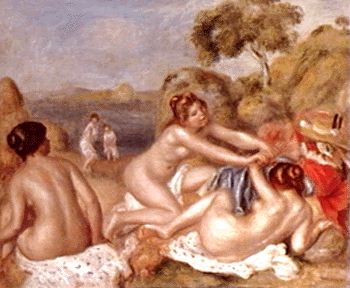
Three Bathers
. ............................. Auguste Renoir
What he lacks in nudity, Baz tries to make up for in his manic glamorous razzle dazzle. But there's something about the nude human body that simply and purely conveys those bohemian ideals of "truth, beauty, freedom and above all love" (emblazoned across the opening and ending of the film) like nothing else. Why do you think those boho artists painted so many nudes? Why do you think the nobility of Europe ventured into the slums of Montmartre to see the can-can? When they did those high kicks, they revealed more than just ruffles; often the can-can dancers wore split knickers that showed off everything!
Though who knows, Luhrman's plucky enough to have slipped some split knickers into some of his lightening fast dance montages. If so, the ratings censors couldn't catch them, and neither could I.
In sum: Bravo to Baz & Company for a dizzying, dazzling movie musical adventure ride! Better plot next time.
SITE INDEX I WHAT'S NEW? I. MEMBERSHIP I THERAPY
FILM
REVIEW
------------------

SEX
. FUN . WISDOM
The
Dr. Susan Block Show
![]()
RADIO SEX TV on HBO

MEMBERSHIP HAS ITS
P L E A S U R E S

BOUDOIR SEX
TOYS


PRESS AREAS
BIOS OF PRINCIPLES

PRESS QUOTES
FRONT
PAGE
DR.
BLOCK'S JOURNAL
RADIOSUZY1.COM
SPEAKEASY
GALLERY
BONOBOS
TRAVEL
& REVIEWS
PRESS ROOM
LAPD PAGE
GREAT
LINKS
GET
ON OUR E-MAIL LIST
SHOPPING
& SERVICES
NEW
SHOPPING & SERVICES
. .
.
PHONE
SEX THERAPY
BOUDOIR
SEX TOYS
VIDEOS
BOOKS
EROTIC
ART
TICKETS & TOURS
INNER
SPACE
LASSE BRAUN
THE
BONDAGE CROSS
PRIVATE
GALLERIES
STREAMING
VIDEO
STORE
LOCATOR
CLASSIFIED
ADS

GPS
FANTASY LIQUID LATEX

See Dr. Susan Block's
DEMOCRATIC
SEX
U N C E N S O R E D

Erotic
Stories, Poetry &
Photographs by the lovely
Anna James

BUSHMAN
A
D E L P H I A
FAMILY CENSORS

Dr. Block's
Open Letter to
John J. Rigas
.

QUILLS:
A Review of
Philip Kaufman's
Film About the
Marquis de Sade
Dr. Susan Block's
DR. LAURA DIARIES

Read Dr. Block's
10 Commandments of
P L E A S U R E
HOT
HOLIDAY SEX
to take
away the
cold, dark, winter
BLUES
FLOWERS,
DILDOS&
PHENYLETHYLAMINE
SEX & TECHNOLOGY:
A MARRIAGE MADE IN
MILLENNIUM MADNESS
FRIGHTENINGLY HOT SEX:
A Halloween Greeting
from Dr. Susan Block

Feet:
A Love Story

CROSSDRESSERS
FOR CHRIST
Impeachment
Chronicles
KOSHER
SEX:
Oneness Through
Shtupping
HALF
PAST AUTUMN:
The Life & Works of
GORDON PARKS
LUSCIOUS
CUNNILINGUS
PLASTIC
FANTASTIC LOVER
AMERICAN SWING
Travels
with Max: ON VIAGRA
KEN STARR: A Pornograher
For Our Times
SEX ACTS IN SOHO with
Heilman-C
LOLITA: a film review

Dr. Block's Story of
QUEEN ESTHER:
How
a Sexy Young
Woman Used the
Power of Seduction
to Save Her People
from Genocide

YALEGASM

Titillating
Tidbits of Democratic Sexat the Democratic Convention

MAYOR
DICK
APOLOGIZES
TO DR. SUZY!

ZONE
VODKA
Benedict Taschen
TASCHEN BOOKS
![]()
GET
A
MOULIN ROUGE BOOK
MOULIN
ROUGE!
The Splendid
Illustrated Book that
Charts the Journey of
Baz Luhrman's
Motion Picture
